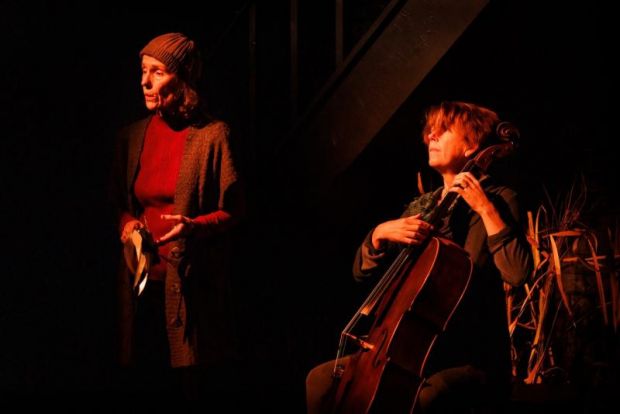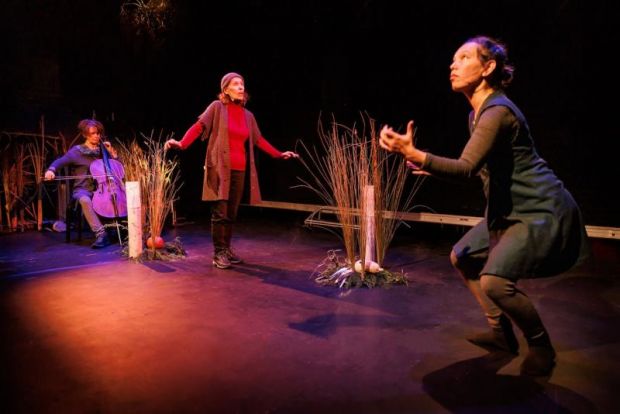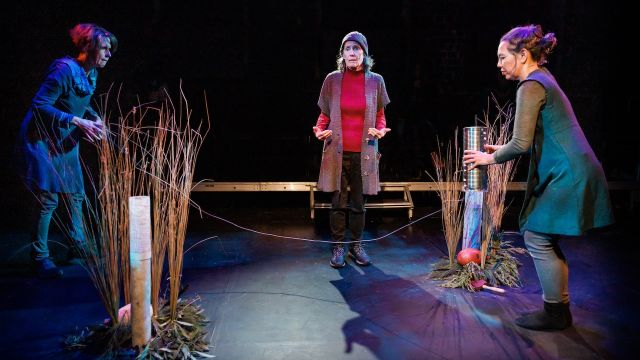The Swallows
Here is a tale of a woman’s (Helen Morse) relation to Nature: her childlike immersion in it – mud between her toes, skin red from icy water - her delicate, wondering observation of nature’s variety, the sunlight through the trees, the sensual feel of a breeze on her skin, her awareness of its silence filled with sounds – birds hidden and seen, the rustle of leaves, the trickle-flow of water – all as she walks and jumps from rock to rock and explores along beside Innocence Creek… Her own little vulnerable world. And then the story tells of her losing that when it is built over and peopled and its sounds are lost in traffic and angry voices.
At the centre, when the creek is bult over or gone underground, the child, now an adult, lives in shabby flats beside or over what was the creek. Her neighbour (also played by Morse) is an angry, possibly violent man, given to random acts of pointless vandalism. His connection to the whole is his lack of connection. There is irony here – and humour – beside the matter-of-fact resilience. And there Morse’s landlady (Morse again), upset, close to panic because of the grass growing between the cracks in the concrete of her asset. But we know that that grass is nature creeping back…

This all comes to us as a monologue spoken by Helen Morse – who has that quiet, riveting, magnetic presence. She speaks softly but with such variation – wonder, happiness, dismay, sadness, and the prickling or tingling of new hope - that we attend to every word. She carries us along through all the changes.
With her story - and inseparable from it - is an intricate, detailed soundscape from Ria Soemardjo and Helen Mountfort. There are hums and threnodies on stringed instruments and drums, and there are sounds that suggest or allude to the sounds of nature – birds, crickets, water - and there are the sounds of the all-conquering humans. These sounds – composed and designed by Soemardjo with Mountfort’s collaboration - weave into and around and beside the spoken word so naturally that we simply accept them – but they can only be the result of thought, imagination and precise planning. They are sometimes startling but never jarring; they are melancholy or bright or tender.

Morse and the musicians glide about the stage which is dotted with tufts of grass and pockets of moss – again a suggestion of nature rather than a realistic reproduction, designed by Joanne Mott. Shane Grant’s lighting is, like the work of his colleagues, absolutely in sync with text and sound: sudden sunlight bathing Morse in warmth, crepuscular shadows, descending gloom, or isolating Morse in realisation or joy.
We might say that The Swallows is ‘poetic’ - and it is – but it avoids abstraction. It is made up of vivid images and descriptions of real things seen and felt. Images of nature, but also of the freeway and its endless traffic, the glow of the servo across the street, the artificial lake (the Lake of Hope) fed by what was the creek – and the barefaced heron, the harbinger of hope.

In its way The Swallows is a quiet lament. There is no narrative per se. It has an arc that goes from wonder and sensation to quiet despair and then to the return of hope – because Nature cannot be destroyed or even built over for too long.
The show lasts almost exactly one hour – which feels just right. It ends where we feel it should – as the arc comes to rest. It is clearly the result of the close and generous collaboration of all concerned – acknowledged by writer and director Sandra Fiona Long but who has, we feel, provided focus and intention. It’s a magical meditation about our contact with or immersion in Nature, about what seems lost but may yet be found.
Michael Brindley
P.S. The Swallows plays at La Mama, the theatre that will be dark through 2025 due to their funding being withdrawn. Shows like this and the artists who make them need La Mama.
Photographer: Darren Gill
Subscribe to our E-Newsletter, buy our latest print edition or find a Performing Arts book at Book Nook.

